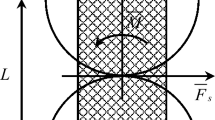Abstract
Cracks in asphalt pavements create irreversible structural and functional deficiencies that increase maintenance costs and decrease lifespan. Therefore, it is important to understand the fracture behavior of asphalt mixtures, which consist of irregularly shaped and randomly oriented aggregate particles and mastic. A two-dimensional clustered discrete element modeling (DEM) approach is implemented to simulate the complex crack behavior observed during asphalt concrete fracture tests. A cohesive softening model (CSM) is adapted as an intrinsic constitutive law governing material separation in asphalt concrete. A homogenous model is employed to investigate the mode I fracture behavior of asphalt concrete using a single-edge notched beam (SE(B)) test. Heterogeneous morphological features are added to numerical SE(B) specimens to investigate complex fracture mechanisms in the process zone. Energy decomposition analyses are performed to gain insight towards the forms of energy dissipation present in fracture testing of asphalt concrete. Finally, a heterogeneous model is used to simulate mixed-mode crack propagation.
















Similar content being viewed by others
References
Buttlar WG, Roque R (1996) Evaluation of empirical and theoretical models to determine asphalt mixture stiffnesses at low temperatures. J Assoc Asphalt Paving Technol 65:99–141
Sadd MH, Dai Q, Parameswaran V, Shukla A (2004) Microstructural simulation of asphalt materials: modeling and experimental studies. ASCE J Mater Civ Eng 16:107–115
Chang CS, Wang TK, Sluys LJ, van Mier JGM (2002) Fracture modeling using a micro-structural mechanics approach—I. Theory and formulation. Eng Fract Mech 69:1941–1958
D’Addetta GA (2004) Discrete models for cohesive frictional materials. Report No. 42, Institute of Structural Mechanics, University of Stuttgart, Germany
Bazant ZP, Planas J (1998) Fracture and size effect in concrete and other quasibrittle materials. CRC Press, New York
Schlangen E, van Mier JGM (1992) Experimental and numerical analysis of the micro-mechanisms of fracture of cement-based composites. J Cem Concr Compos 14(2):105–118
Majidzadeh K, Kauffmann EM, Ramsamooj DV (1971) Application of fracture mechanics in the analysis of pavement fatigue. J Assoc Asphalt Paving Technol 40:227–246
Abdulshafi AA, Majidzadeh K (1985) J-integral and cyclic plasticity approach to fatigue and fracture of asphalt mixes. J Transp Res Rec 1034:112–123
Kim KW, El Hussein HM (1995) Effect of differential thermal contraction on fracture properties of asphalt materials at low temperature. J Assoc Asphalt Paving Technol 64:474–499
Jacob MM, Hopman PC, Molenaar AAA (1996) Application of fracture mechanics in principles to analyze cracking in asphalt concrete. J Assoc Asphalt Paving Technol 65:1–39
Jenq Y, Perng J (1991) Analysis of crack propagation in asphalt concrete using cohesive crack model. J Transp Res Rec 1317:90–99
Paulino GH, Song SH, Buttlar WG (2004) Cohesive zone modeling of fracture in asphalt concrete. In: Proceeding of fifth RILEM international conference on pavement cracking, Limoges, France
Chang KG, Meegoda JN (1997) Micromechanical simulation of hot mix asphalt. J Eng Mech 123(5):495–503
Kim H, Buttlar WG (2005) Micromechanical fracture modeling of hot-mix asphalt concrete based on a disk-shaped compact tension test. J Assoc Asphalt Paving Technol 74E
Itasca Consulting Group, Inc (2002) PFC 2D version 3.0. Itasca Consulting Group, Inc, Minneapolis, USA
Cundall PA (1971) A computer model for simulating progressive, large-scale movements in blocky rock systems. In: Proceedings of the international symposium of rock fracture, Nancy, France
O’Sullivan C, Bray JD (2001) A comparative evaluation of two approaches to discrete element modeling of particulate media. In: Proceedings of the fourth international conference on discontinuous deformation, University of Glasgow, Scotland, UK, pp 97–110
Dugdale D (1960) Yielding of steel sheets containing slits. J Mech Phys Solids 8:100–104
Barenblatt GI (1962) Mathematical theory of equilibrium cracks in brittle fracture. Adv Appl Mech 7:55–129
Hillerborg A, Modeer M, Petersson PE (1976) Analysis of crack formation and crack growth in concrete by means of fracture mechanics and finite elements. Cem Concr Res 6(6):773–782
Tavarez FA, Plesha ME (2006) Discrete element method for modelling solid and particulate materials. Int J Numer Methods Eng 70(4):379–404
Davie CT, Bićanic N (2003) Failure criteria for quasi-brittle materials in lattice-type models. Commun Numer Methods Eng 19:703–713
Lawn B (1993) Fracture of brittle solids. Cambridge solid state science series. Cambridge University Press, Cambridge
Wagoner MP, Buttlar WG, Paulino HG (2005) Development of a single-edge notched beam test for asphalt concrete mixtures. J Test Eval 33(6):452–460
Wagoner MP (2006) Fracture tests for bituminous-aggregate mixtures: laboratory and field investigations. Ph.D. Dissertation, University of Illinois at Urbana-Champaign
AASHTO T322-03 (2004) Standard test method for determining the creep compliance and strength of hot mix asphalt (HMA) using the indirect tensile test device. Standard specifications for transportation materials and methods of sampling and testing, 24th edn
Kim H, Wagoner MP, Buttlar WG (2008) Simulation of fracture behavior in asphalt concrete using a heterogeneous cohesive zone discrete element model. ASCE J Mater Civ Eng 20(8):1–12
Schlangen E, Garboczi EJ (1997) Fracture simulations of concrete using lattice models: computational aspects. Eng Fract Mech 57(2/3):319–332
Media Cybernetics, Inc. (2004) Image-Pro Plus 5.0. Silver Spring, Maryland, USA
You Z (2003) Development of a micromechanical modeling approach to predict asphalt mixture stiffness using the discrete element method. Ph.D. Dissertation, University of Illinois at Urbana-Champaign
Tschegg EK, Stanzl-Tschegg SE, Litzka J (1993) New testing method to characterize mode I fracturing of asphalt aggregate mixture. In: Proceeding of 2nd RILEM conference, London, England, pp 263–270
Author information
Authors and Affiliations
Corresponding author
Rights and permissions
About this article
Cite this article
Kim, H., Wagoner, M.P. & Buttlar, W.G. Micromechanical fracture modeling of asphalt concrete using a single-edge notched beam test. Mater Struct 42, 677–689 (2009). https://doi.org/10.1617/s11527-008-9412-8
Received:
Accepted:
Published:
Issue Date:
DOI: https://doi.org/10.1617/s11527-008-9412-8




